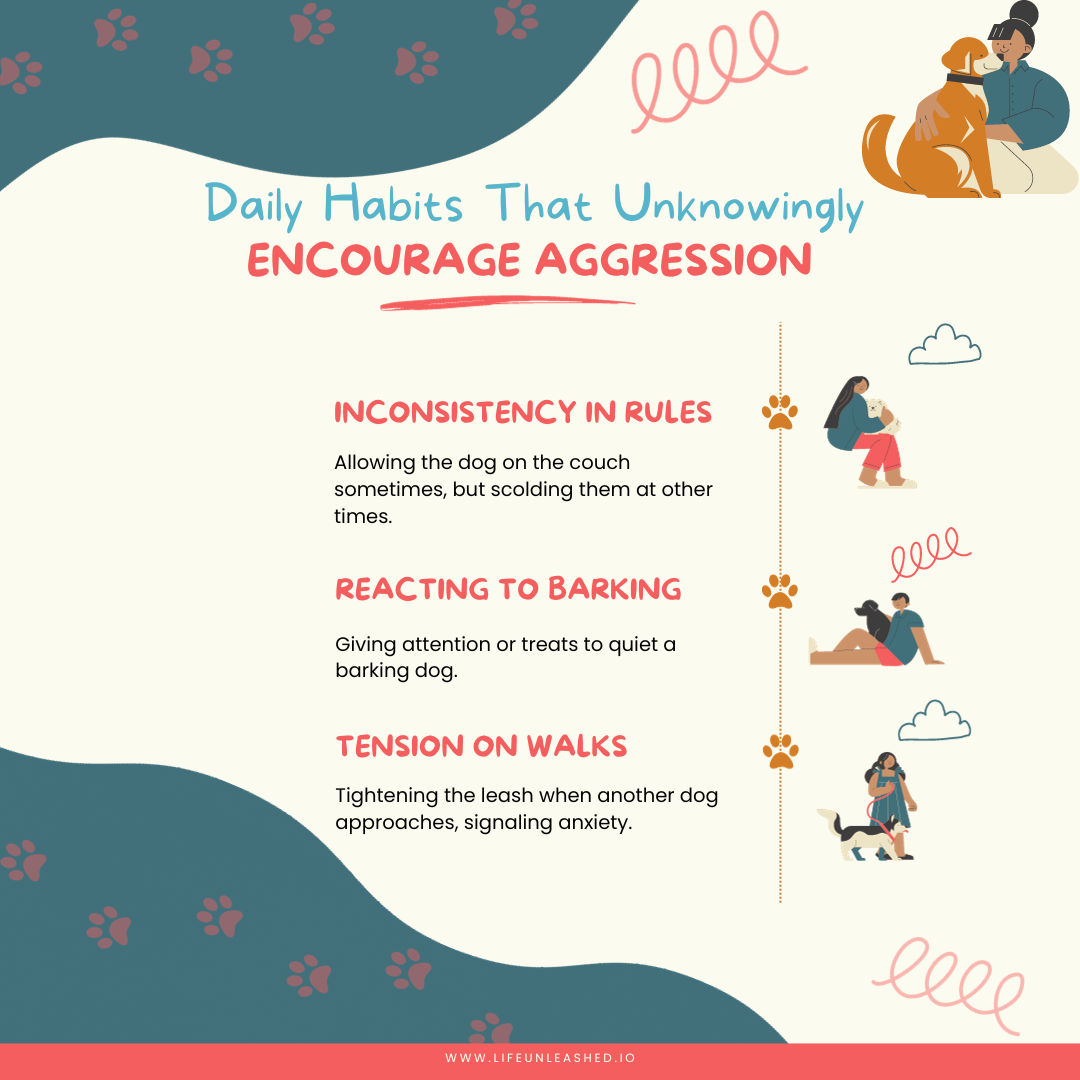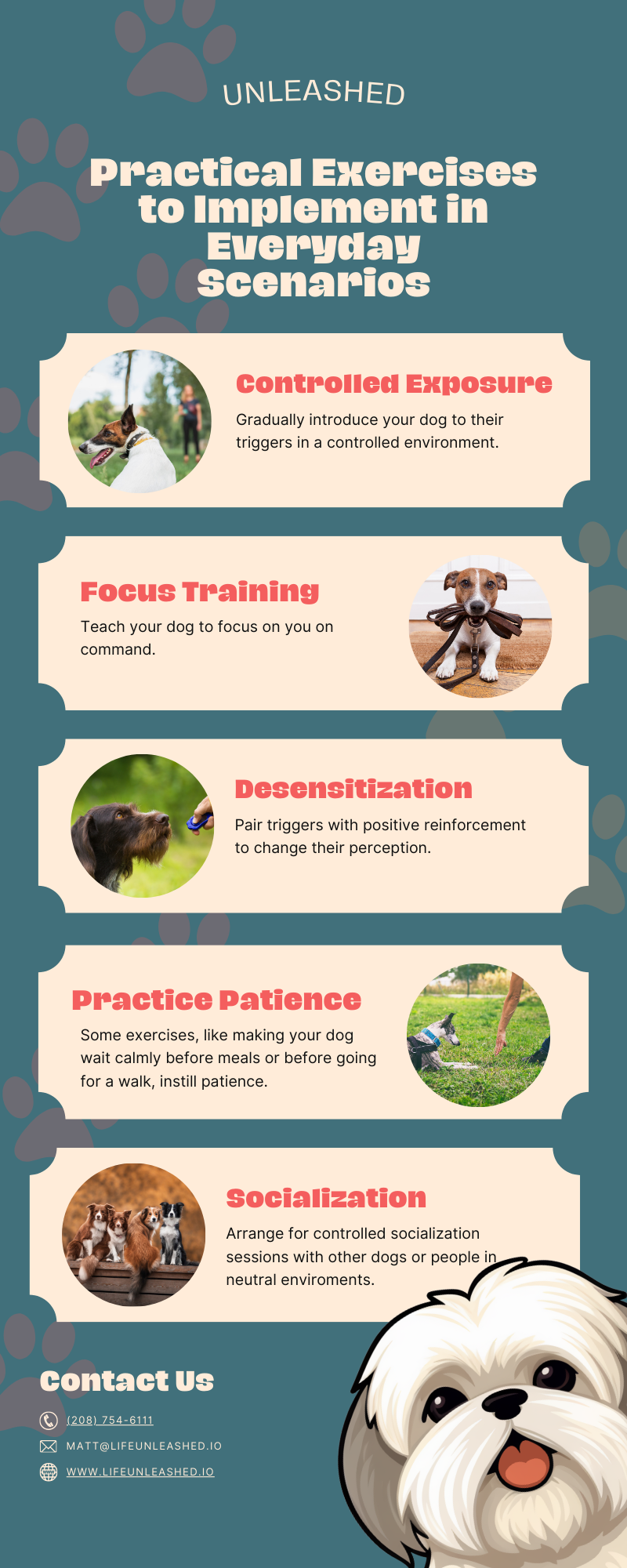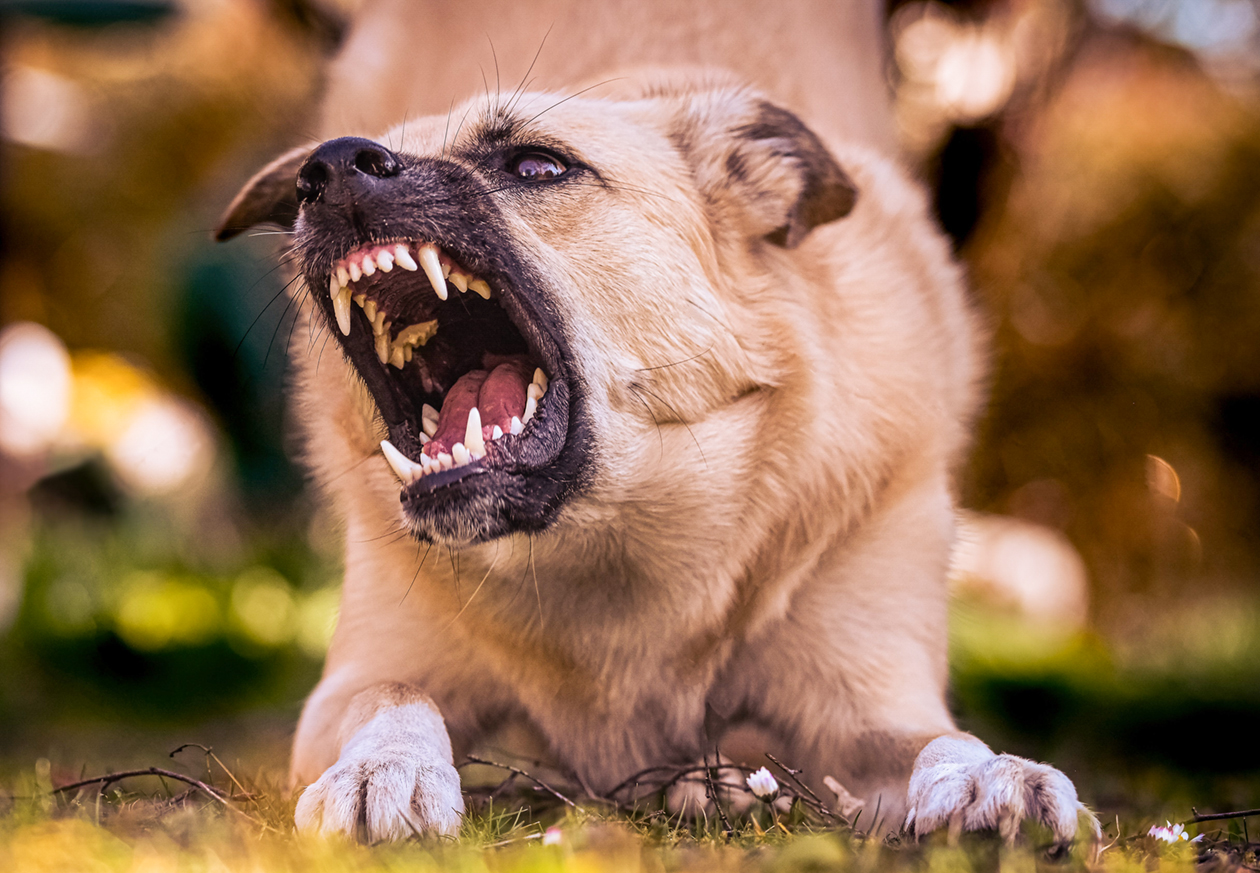Nearly 4.5 million people are bitten by dogs each year, with children being the most common victims of aggressive dogs. But here’s the twist: it’s not always about the dog’s nature; sometimes, it’s about understanding and guidance.
If you’ve ever found yourself puzzled by dog’s aggressive behavior wondering, ‘Why is my dog acting this way?’, you’re far from alone
A surprising number of dog owners face the challenge of managing aggression in their furry friends. One moment they’re all cuddles and tail wags, and the next, it’s like dealing with a four-legged Hulk.
In this guide on aggressive dog training, we dig deep into the various aspects of dog aggression and how to transform challenging behavior into positive outcomes.
Understanding Dog Aggression: More Than Just Bad Behavior
When you see a dog lashing out, it’s easy to label it as ‘bad behavior’. But what if I told you that aggression in dogs is often a symptom, not the problem itself? It is a symptom indicating a need for aggressive dog training. Think of aggression as a language, a way dogs communicate their deeper issues. It’s like a person lashing out when they’re in pain.
Often, aggression stems from various forms.. It’s crucial to look beyond the growls and barks to understand what’s really troubling your furry friend.
- Fear-based aggression: Often, a dog that snaps at strangers might be acting out of fear, not hostility. This can stem from past trauma or insufficient socialization during their formative puppy years.
- Territorial aggression: Some dogs may display aggression to proctect their perceived territory, including their home, yard, or even their human family members.
- Resource guarding: This type of aggression occurs when a dog is overly protective of their possessions, such as food, toys, or even a favorite resting spot.
- Predatory aggression: Some dogs may exhibit aggression that stems from their predatory instincts, which can be triggered by moving objects or smaller animals
Understanding this can completely change how you approach their training.
Did you know that something as simple as your dog’s diet or physical health could impact their behavior? Imagine you’re feeling hungry and how quickly that can turn into “hangry.” Dogs are no different. Health issues like thyroid problems, pain, or dietary deficiencies can lead to increased irritability and aggression.
Even factors like the environment – a chaotic household, lack of exercise, or inconsistent training – play a significant role. Consider a dog that’s cooped up all day in a small apartment, with minimal exercise or stimulation. Their pent up energy and frustration might manifest as aggressive outbursts.
It’s not their nature; it’s their environment shaping their behavior. Recognizing these factors is the first step in addressing aggression in dogs effectively.
Can Aggression Be Trained Out of a Dog?
While aggression can often be managed and significantly reduced through targeted aggressive dog training, promising that a dog will become completely non-aggressive is like promising a storm will never hit a calm sea. It’s about setting realistic goals and understanding that training is a journey, not a quick fix.
Sometimes, it’s a good idea to consult a dog behaviorist for help. Consider a dog that’s been aggressive for years due to a traumatic experience. The goal of training isn’t to erase their past, but to teach them healthier ways to cope. It’s about progress, not perfection.
You might be curious about the distinction between a dog trainer and dog behaviorist?
Now, let’s talk about how to achieve these goals. Positive reinforcement isn’t just a fancy phrase – it’s a proven method. It’s about rewarding the behavior you want, not punishing the behavior you don’t. Think of it as catching your dog in the act of doing something good, and saying, “Yes! That’s exactly what I want!” This approach builds trust and encourages your dog to repeat those positive behaviors.
On the flip side, punishment – like yelling or physical correction – often backfires. It may suppress the aggression temporarily, but it’s like putting a lid on a boiling pot without turning off the stove. The aggression is still there, simmering, and might resurface stronger.
Instead, guiding your dog to the desired behavior with patience and understanding is what truly transforms an aggressive dog into a calmer, more confident companion.
Celebrate the small victories – maybe today they growled less at a stranger, or took a treat gently without snapping. These moments are huge in the world of dog training.
Transformative Techniques for Aggressive Dogs
Have you ever noticed how your mood mirrors your surroundings? The same goes for dogs, especially those dealing with aggression. A calm environment can work wonders. It’s not just about a quiet space, but a predictable and secure setting that helps your dog feel at ease.
Think about your home environment. Is it chaotic, with loud noises and constant movement, or is it a peaceful haven? Creating a calm zone for your dog, where they can retreat when feeling overwhelmed, is crucial. This could be a corner with their favorite bed and toys, away from the hustle and bustle.
Even your demeanor plays a role. Dogs are incredibly attuned to our emotions. If you’re anxious or agitated, chances are, your dog will mirror that. Approach your dog with a relaxed and gentle demeanor. Your calm presence reassures them that there’s nothing to fear or be aggressive about.
Moving beyond the conventional “sit” and “stay,” let’s delve into innovative training techniques for aggressive dogs. One such method is desensitization – gradually and gently exposing your dog to the things that trigger their aggression, in a controlled way. It’s like slowly turning up the volume on a scary movie, so it becomes less frightening over time.
Another technique is counter-conditioning. This involves changing your dog’s emotional response to a trigger. For instance, if your dog growls at strangers, pairing the sight of a stranger with something positive like their favorite treat can change their perception from threatening to rewarding.
These methods require patience and consistency, but the transformation they can bring about is remarkable. It’s about rewiring how your dog perceives and reacts to what currently triggers their aggression.
How to Train an Aggressive Dog to Be Friendly: Patience and Consistency
Turning an aggressive dog into a friendly, sociable pet is like trying to solve a complex puzzle. It takes patience, understanding, and above all, consistency. Start with small, manageable goals. Maybe today, the goal is just getting your dog to tolerate the presence of another dog across the street.
Incorporate regular training sessions, but keep them short to prevent your dog from feeling overwhelmed. Consistency is key. Dogs thrive on routine, and regular, predictable training helps reinforce the learning process.
Socialization is another important aspect. Gradually introduce your dog to new people, animals, and environments in a safe, controlled manner. Think of it as expanding their world, one step at a time. Remember, every positive interaction is a step forward.
Should You Punish an Aggressive Dog? Exploring Effective Disciplinary Methods
One of the most common questions dog trainers address is whether it is appropriate to punish an aggressive dog. The short answer? Punishment often does more harm than good. It can heighten the aggression, making your dog more fearful or defensive.
Instead of punishment, focus on redirecting your dog’s behavior. When they exhibit aggression, redirect them to an alternative, more desirable behavior. For instance, if they bark aggressively at the door, train them to go to their bed instead. Instead of punishing the aggression, teach them a better way to respond.
Positive reinforcement plays a vital role here. Rewarding your dog for non-aggressive behavior reinforces what you want to see more of. Focus on guiding, not scolding. Remember, the goal is to build trust and confidence, not fear.
Addressing the Question: “How Do I Stop My Dog from Being Aggressive?”

Tackling your dog’s aggression starts with understanding its roots. Just like people, dogs have varied personalities and triggers. Recognizing the type of aggression your dog exhibits is crucial for effective training.
For example, fear-based aggression requires a different approach than territorial aggression. A dog that snarls when scared needs gentle reassurance and gradual exposure to their fears. On the other hand, a dog guarding their space might need structured training to learn that not every newcomer is a threat.
Here’s a pro tip: Observe and note the situations that trigger your dog’s aggression. Is it other dogs, strangers, or specific situations like vet visits? Tailoring your training to these triggers will make your efforts much more effective.
Sometimes, without realizing it, our everyday behaviors can reinforce our dog’s aggressive tendencies. Are you unconsciously rewarding their aggression? For example, if your dog growls at the mailman and you soothe them, they might think growling is the way to earn your affection.
Consistency is key. Make sure everyone in your household understands and follows the same rules regarding your dog’s behavior. Mixed signals can confuse your dog, making the training process much harder.
Also, pay attention to your reactions. Are you tense or anxious around other dogs or people? Remember, dogs are incredibly attuned to our emotions. Your anxiety can signal to your dog that they should be wary or protective in these situations.
Practical Exercises to Implement in Everyday Scenarios
Now, let’s put this knowledge into action with some practical exercises. These are designed to be integrated into your daily routine, making the training process a natural part of your interaction with your dog.

- Controlled Exposure: Gradually introduce your dog to their triggers in a controlled environment. If they’re aggressive towards other dogs, start by walking them at a distance from other canines. Gradually decrease this distance as they become more comfortable.
- Focus Training: Teach your dog to focus on you on command. This can redirect their attention from a trigger and prevent an aggressive response. Use a command like “Look at me” followed by a treat or praise when they comply.
- Desensitization: If your dog reacts aggressively to specific sounds, start by playing recordings of these sounds at a low volume, gradually increasing it as they become accustomed. Pair this with positive reinforcement to change their perception.
- Practice Patience: Some exercises, like making your dog wait calmly before meals or before going for a walk, instill patience and reduce impulsiveness. These behaviors can translate to calmer responses in potentially aggressive situations.
- Socialization Sessions: If possible, arrange for controlled socialization sessions with other dogs or people. Ensure these are in a neutral environment and closely monitored. This can help your dog learn appropriate social behaviors and reduce aggression.
In summary, addressing dog aggression involves understanding its nature, avoiding reinforcing negative behaviors, and integrating practical training exercises into your daily life. Remember, every dog is unique, and so is their journey towards becoming less aggressive. Patience, consistency, and understanding are your best tools in this transformation process.
Take the Leap to Expert Dog Training with Unleashed
You’ve just soaked up a treasure trove of information on mastering aggressive dog training, filled with essential handling tips and command reminders. But what if you could elevate this knowledge to new heights with the help of a professional?
This is where Unleashed steps into the picture. We can help you bridge the gap between knowledge and finding the right dog trainer to help you calm your aggressive dog.
Contact one of the Unleashed dog trainers today and transform your dog training experience.
FAQs about Training Aggressive Dogs
What causes aggression in dogs?
Aggression in dogs can be caused by various factors, including fear, territorial instincts, lack of socialization, past trauma, medical issues, or genetic predisposition. Identifying the root cause is crucial for effective training.
Can aggressive behavior in dogs be fixed?
In many cases, aggressive behavior can be managed and improved through consistent training and behavior modification. However, complete “fixing” may not always be possible, and ongoing management may be required.
Should I attempt to train an aggressive dog on my own?
It is highly recommended to seek professional help when dealing with aggression in dogs. A qualified dog trainer or behaviorist can assess the situation, create a customized training plan, and provide guidance to ensure safety.
What training methods are effective for aggressive dogs?
Positive reinforcement-based training methods are generally recommended. Rewarding good behavior and redirecting negative behavior can help reshape the dog’s responses. Avoid punitive measures, as they can escalate aggression.
How long does it take to see improvements in aggressive behavior?
The timeline for improvement varies based on the severity of the aggression, the dog’s history, and the consistency of training. Patience and persistence are key, and results may take weeks to months.
Can medication help in treating aggression in dogs?
In some cases, medication prescribed by a veterinarian may be used in conjunction with behavior modification. This approach is typically reserved for severe cases or when there is an underlying medical issue contributing to aggression.
What safety precautions should be taken when working with an aggressive dog?
Safety is paramount. Use muzzles, secure leashes, and other appropriate equipment when handling an aggressive dog. Always consult with a professional before attempting any hands-on training with an aggressive dog.
Should an aggressive dog be socialized with other dogs or people?
Socialization is important, but it should be done under the guidance of a professional. Gradual, controlled exposure to positive experiences can help reshape the dog’s behavior. However, safety should always be the top priority.
Can children be around an aggressive dog during training?
It is generally not advisable for children to be around an aggressive dog during training sessions. A professional trainer can provide guidance on managing interactions and ensuring everyone’s safety.
What should I do if my aggressive dog is showing signs of improvement?
Continue working with a professional, follow the training plan consistently, and celebrate small successes. Regularly reassess the dog’s progress and adjust the training plan as needed.



